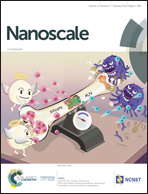Direct Z scheme-fashioned photoanode systems consisting of Fe2O3 nanorod arrays and underlying thin Sb2Se3 layers toward enhanced photoelectrochemical water splitting performance†
Abstract
An elegant Z-scheme-fashioned photoanode consisting of Fe2O3 nanorod arrays and underlying thin Sb2Se3 layers was rationally constructed. The photocurrent density of the Sb2Se3–Fe2O3 Z-scheme photoanode reached 3.07 mA cm−2 at 1.23 V vs. RHE, three times higher than that of pristine Fe2O3 at 1.03 mA cm−2. An obvious cathodic shift of the photocurrent onset potential of about 200 mV was also observed. The transient photovoltage response demonstrates that the suitable band edges (ECB ∼ −0.4 eV and EVB ∼ 0.8 eV) of Sb2Se3, match well with Fe2O3 (ECB ∼ 0.29 eV and EVB ∼ 2.65 eV), permitting the photoexcited electrons on the conduction band of the Fe2O3 to transfer to the valence band of Sb2Se3, and recombine with the holes therein, thus allowing a high concentration of holes to collect in the Fe2O3 for water oxidation. The transient absorption spectra further corroborate that the built-in electric field in the p–n heterojunction leads to a more effective separation and a longer lifetime of the charge carriers.

- This article is part of the themed collection: 2018 Nanoscale HOT Article Collection


 Please wait while we load your content...
Please wait while we load your content...